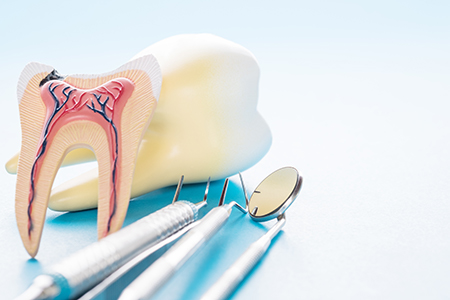General & Cosmetic Dentistry
The office of Keith A. Kye, DDS, FAGD serves the neighborhoods of Huntersville, Lake Norman, Davidson and Cornelius.


If a dentist tells you a tooth needs a root canal, try not to panic. Modern root canal therapy is a predictable, pain-relieving treatment designed to save a damaged tooth and protect the rest of your smile. With today’s anesthetics, instruments, and techniques, most patients experience a comfortable visit and leave with the source of their toothache controlled.
At the office of Keith A. Kye, DDS, FAGD, we emphasize careful diagnosis, clear communication, and gentle treatment so you understand what’s happening and why. Our goal is to preserve your natural teeth whenever possible while helping you return quickly to normal eating and daily life.
Keeping a tooth in place has advantages that go beyond cosmetics. A natural tooth maintains proper alignment, supports the surrounding bone, and helps preserve your ability to chew efficiently. When a tooth is removed, neighboring teeth can shift and bite forces on the remaining teeth increase, making future problems more likely.
Root canal therapy offers a way to remove infected or damaged tissue from inside a tooth while leaving the outer structure intact. In many cases this approach prevents the need for extraction and a replacement option, which often requires more complex care over time.
Thanks to high success rates and durable materials, a tooth treated with modern root canal techniques can function reliably for years — often for the remainder of a patient’s lifetime when it is properly restored and maintained.

Under the hard outer layers, each tooth contains a small chamber that houses the dental pulp — a delicate mix of nerves, blood vessels, and connective tissue. When decay reaches this inner chamber, or when a tooth is injured, the pulp can become inflamed or die. Without treatment, the infection can spread to the root tip and surrounding bone.
Not every ache means a root canal is needed, but certain patterns of discomfort and change suggest internal trouble. Persistent, throbbing pain that lingers after eating hot or cold foods, increased pain when biting, or a tooth that darkens over time are all warning signs. Sometimes a patient may notice swelling or an occasional bad taste from drainage, which indicates an infection requiring prompt attention.
It’s also possible for a tooth to be compromised with little or no pain. Regular dental exams and x-rays can reveal hidden problems. Early detection often leads to simpler treatment and better long-term outcomes. If you notice any of the symptoms above, seek evaluation sooner rather than later.

Treating an infected tooth at the first signs of trouble usually reduces discomfort, limits the extent of infection, and preserves more of the natural tooth. Delaying care can allow an infection to deepen, cause greater bone loss around the root, and create the need for more involved procedures.
Prompt care also minimizes the chance that the problem will affect adjacent teeth or create systemic issues. While severe dental infections are uncommon when handled appropriately, they can lead to complications if left untreated.
Our team will evaluate the tooth using a combination of visual examination, digital x-rays, and tests for vitality and function. Based on those findings, we’ll outline the recommended course of treatment and explain what to expect at each step.
Root canal therapy is designed to remove diseased tissue from the tooth’s internal canals, clean and shape those spaces, and seal them to prevent reinfection. The work is done under local anesthesia, so most patients feel little to no pain during the procedure. In some cases, we offer additional comfort options for patients who experience anxiety.
Some teeth are straightforward and can be treated in a single visit, while others — for example, molars with multiple canals or teeth with active infection — may require two appointments to manage inflammation and complete the restoration. The dentist will discuss the expected timeline before treatment begins.
After cleaning and filling the canals with a biocompatible material, the tooth typically receives a protective restoration. A crown or similar restoration strengthens the tooth and restores normal function, helping prevent fractures and protecting the work that was completed inside the tooth.

Following a root canal, you can expect some tenderness or mild soreness for a few days as surrounding tissues heal. Over-the-counter pain relievers are usually sufficient, and your dentist will provide guidance if prescription medication is ever needed. If antibiotics are prescribed to manage an infection, be sure to complete the full course.
Because a treated tooth may be more brittle than an untouched tooth, placing a permanent crown or other appropriate restoration in a timely manner is important to prevent fracture. Until that permanent restoration is placed, avoid chewing hard or sticky foods on the treated side.
Good oral hygiene and regular dental checkups help safeguard the treated tooth and the rest of your mouth. With careful maintenance, a root canal–treated tooth can remain healthy and functional for many years.
In summary, root canal therapy is a reliable way to relieve pain, eliminate infection, and preserve your natural tooth when the pulp has been damaged. The procedure is performed with modern tools and anesthesia to prioritize your comfort and long-term oral health.
If you have symptoms or questions about whether a root canal is the right option, please contact our office for more information and an evaluation.
A root canal procedure is the best way to save a tooth that has been damaged by decay or injury and preserve your natural smile. The alternative is an extraction and treatment to replace the tooth. While at times a tooth is non-restorable and an extraction is the only option, when possible, it’s best to try and save your natural tooth. With proper care, a tooth with root canal therapy can serve your smile well for many years to come.
Despite lingering myths from before the age of modern dental anesthesia and technology, having a root canal procedure today is as routine and comfortable as visiting the dentist for a filling. While the procedure is performed under local anesthesia with your tooth completely numbed, we can also discuss options in dental sedation.
Whether the symptoms of a dental infection subside after a course of antibiotics, a draining abscess provides you with some temporary pain relief, or a tooth with radiographic evidence of pathology has not yet developed symptoms, it’s essential, before an infection worsens or occurs, to have a root canal procedure performed. In this way, the tooth can be disinfected, filled, and sealed to protect your health and avoid further problems.
If you have sustained a dental injury, have a toothache, jaw pain, swelling, or are experiencing any other unusual and uncomfortable oral symptoms, contact our office immediately for care. Dental problems that have not been evaluated and treated can significantly worsen, producing more severe damage and consequences for the involved teeth, your oral health, and even your overall wellbeing. Once you get in touch with our office, our friendly and compassionate office team will get you in for care at your earliest convenience.
While some root canal procedures can be completed in one visit, others may involve 2 or 3 appointments. How long it takes depends on various factors, including active infection, the number of canals in the tooth, and the tooth’s location or anatomy.
With a success rate that exceeds 95%, root canal therapy remains the most effective procedure to save a tooth in which the inner vital tissues have been damaged. However, as with all healthcare procedures, there are a small percentage of cases where the teeth become symptomatic a second time. The good news is that many of these teeth can still be saved with root canal retreatment or a minor surgical procedure known as an apicoectomy.
The best ways to maintain a tooth with root canal therapy are to get the proper restoration required to rebuild and protect the tooth, maintain proper oral hygiene, and schedule appointments for routine dental checkups and care.
Saving a tooth with root canal therapy is a wise investment that, in the long run, is typically less costly and invasive than having the tooth extracted and replaced with a fixed bridge or implant. As far as the exact cost of care, it can vary depending on which tooth is being treated. Many dental insurance plans provide coverage for root canal therapy. At the office of Keith A. Kye, DDS, FAGD, we do our best to optimize your dental benefits and minimize your out-of-pocket expenses. Our staff will answer all your questions about the cost of care and discuss all your payment options.
At the office of Keith A. Kye, DDS, FAGD, we use the latest technology and most effective methods of care to provide precise and gentle care. Our reputation for excellence is based upon a consistent record of achieving successful treatment outcomes while providing prompt, stress-free, and convenient treatment for every type of dental need.
A root canal, formally called root canal therapy, treats the soft tissue inside a tooth that has become inflamed or infected. It involves removing damaged pulp, cleaning and shaping the internal canals, and sealing them to prevent reinfection. This procedure relieves pain and stops the spread of infection while preserving the natural tooth structure.
Modern root canal techniques use local anesthesia and refined instruments to make the treatment comfortable and predictable. When combined with an appropriate restoration, a treated tooth can function for many years and often for a lifetime. Early diagnosis and timely treatment improve outcomes and reduce the need for more complex care later.
Persistent, throbbing pain that lingers after exposure to hot or cold, increased pain when biting, and swelling near a tooth are common signs that the dental pulp may be compromised. A tooth that darkens over time or the presence of a recurring bad taste or drainage can also indicate infection. Not all toothaches require a root canal, but these patterns warrant prompt evaluation by a dentist.
Some teeth with internal damage cause little or no pain, making regular dental exams and X-rays important for detection. Digital radiography and intraoral cameras help reveal problems that are not yet symptomatic, allowing for earlier, simpler treatment. If you notice any of these signs, seek an exam so the condition can be assessed and addressed before it worsens.
Diagnosis begins with a visual exam and a review of symptoms, followed by diagnostic tests to assess the pulp and supporting structures. We commonly use digital X-rays to look for changes in the root and surrounding bone and may perform vitality testing to gauge nerve responsiveness. In certain cases, additional imaging or a specialist consultation may be recommended to clarify complex anatomy or the extent of infection.
Your dentist will explain the findings and recommend either root canal therapy or an alternative based on the tooth's prognosis and your overall oral health. Clear communication about the diagnosis and next steps helps patients make informed decisions and reduces uncertainty. This evaluation-focused approach is part of the office of Keith A. Kye, DDS, FAGD's commitment to conservative, patient-centered care.
Root canal treatment starts with local anesthesia to numb the tooth and surrounding tissues so most patients feel little to no pain during the procedure. The dentist then creates a small access opening to reach the pulp chamber and uses specialized files and irrigants to remove diseased tissue and disinfect the canal system. After shaping, the canals are filled with a biocompatible material and sealed to prevent reinfection.
Some teeth can be treated in a single visit while others, such as molars with multiple canals or teeth with active infection, may require two visits to manage inflammation fully. Following the root canal, a protective restoration—often a crown—is placed to restore strength and function and to reduce the risk of fracture. Your dentist will discuss the treatment timeline and any restorative steps needed to complete care.
Anesthesia and modern techniques make the procedure itself generally comfortable, and many patients report significant pain relief immediately after treatment. It is normal to experience mild soreness or tenderness for a few days as surrounding tissues heal. Over-the-counter pain relievers are usually sufficient to manage this discomfort, and your dentist will advise if stronger medication is ever needed.
If you experience increasing pain, swelling, a fever, or other worrying symptoms after treatment, contact your dental office promptly for evaluation. Occasionally antibiotics are prescribed to address active infection, but they do not substitute for the mechanical cleaning and sealing that a root canal provides. Timely follow-up care helps ensure proper healing and a successful long-term outcome.
Appointment length depends on the tooth and the complexity of the case; many root canals take between 60 and 90 minutes, but simpler teeth may be completed more quickly. Molars with several canals or teeth that require treatment of an active infection commonly need two appointments to complete the process safely and comfortably. Your dentist will estimate the expected number of visits during the consultation so you can plan accordingly.
After the canal system is sealed, placing a permanent crown or similar restoration is often the next step to protect the tooth from fracture and restore chewing function. This restorative phase may require a separate appointment with impressions or digital scans, temporary protection, and a follow-up visit to cement the final restoration. Completing the restorative work in a timely manner is important to the long-term success of the treated tooth.
The primary alternatives to root canal therapy are extraction of the tooth followed by a replacement option such as an implant, bridge, or removable partial denture. Removing a tooth changes how forces are distributed across the bite and can lead to movement of neighboring teeth and loss of supporting bone over time. For many patients, preserving the natural tooth with root canal therapy and a crown offers the most conservative path to maintaining oral function.
Your dentist will discuss the advantages and limitations of each approach in the context of your oral health, medical history, and personal preferences. Some situations—extensive structural damage, poor prognosis, or other health considerations—may make extraction the more appropriate choice. Shared decision-making ensures that the chosen plan aligns with your goals for comfort, function, and long-term oral health.
Root canal treatment has a high success rate, but reinfection is possible if bacteria re-enter the sealed canals, if new decay develops, or if a crack allows contamination. Symptoms of reinfection can include renewed pain, swelling, or changes on radiographs during follow-up exams. When problems occur, options include retreatment to clean and reseal the canals, surgical treatment to address the root tip, or extraction if the tooth cannot be predictably saved.
Outcomes for retreatment are generally favorable when performed promptly by an experienced clinician and when the restorative integrity of the tooth can be restored. Maintaining good oral hygiene and attending regular checkups helps reduce the risk of reinfection and preserves the treated tooth. Your dentist will review signs to watch for at home and schedule appropriate follow-up imaging to monitor healing.
After a root canal, protect the treated tooth by avoiding hard, sticky, or excessively chewy foods until your permanent restoration is placed. Maintain excellent oral hygiene with regular brushing and flossing to reduce the chance of new decay forming around the restoration. If a temporary filling was placed, be cautious not to fracture or dislodge it, and contact your dentist promptly if this occurs.
Attend the recommended follow-up appointments so the dentist can verify healing with clinical exams and radiographs and complete the final restoration when appropriate. Long-term success depends on both the quality of the endodontic treatment and the protective restoration that follows, so timely crown placement is important. With proper care, most root canal-treated teeth continue to function well for many years.
To prepare for your root canal appointment, bring a list of current medications and any relevant medical history, and let the office know if you experience dental anxiety or specific health concerns. Eating a light meal before the appointment and arranging transportation if you expect to receive sedation or feel nervous can make the visit more comfortable. The dental team will review the treatment plan, answer your questions, and explain any comfort options available during the procedure.
After treatment, follow the dentist's instructions regarding medications, oral care, and restrictions on chewing until the restoration is placed. Keep scheduled follow-up visits and contact the office if symptoms persist or worsen, as prompt attention preserves outcomes. If you live near Huntersville, NC, or are an existing patient, contact the office to schedule an evaluation and learn more about how we approach root canal care.

The office of Keith A. Kye, DDS, FAGD serves the neighborhoods of Huntersville, Lake Norman, Davidson and Cornelius.